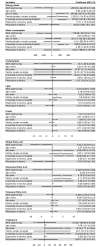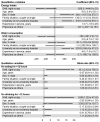The Negative Impact of Night Shifts on Diet in Emergency Healthcare Workers
- PMID: 35215482
- PMCID: PMC8876008
- DOI: 10.3390/nu14040829
The Negative Impact of Night Shifts on Diet in Emergency Healthcare Workers
Abstract
Despite the consequences of night-shift work, the diet of night-shift workers has not been widely studied. To date, there are no studies related to food intake among emergency healthcare workers (HCWs). We performed a prospective observational study to assess the influence of night work on the diet of emergency HCWs. We monitored 24-h food intake during a day shift and the consecutive night, and during night work and the daytime beforehand. We analyzed 184 emergency HCWs' food intakes. Emergency HCWs had 14.7% lower (-206 kcal) of their 24-h energy intake during night shifts compared to their day-shift colleagues (1606.7 ± 748.2 vs. 1400.4 ± 708.3 kcal, p = 0.049) and a 16.7% decrease in water consumption (1451.4 ± 496.8 vs. 1208.3 ± 513.9 mL/day, p = 0.010). Compared to day shifts, night-shift had 8.7% lower carbohydrates, 17.6% proteins, and 18.7% lipids. During the night shift the proportion of emergency HCWs who did not drink for 4 h, 8 h and 12 h increased by 20.5%, 17.5%, and 9.1%, respectively. For those who did not eat for 4 h, 8 h and 12 h increased by 46.8%, 27.7%, and 17.7%, respectively. A night shift has a huge negative impact on both the amount and quality of nutrients consumed by emergency healthcare workers.
Keywords: nutrients; prevention; public health; quality of life; well-being; work.
Conflict of interest statement
The authors declare no conflict of interest.
Figures





References
-
- Convention C171—Night Work Convention, 1990 (No. 171) [(accessed on 4 November 2021)]. Available online: https://www.ilo.org/dyn/normlex/en/f?p=NORMLEXPUB:12100:0::NO::P12100_IN....
Publication types
MeSH terms
LinkOut - more resources
Full Text Sources

